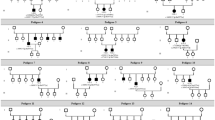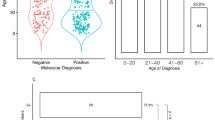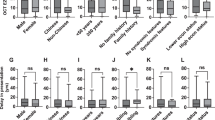Abstract
Purpose
Understanding the incidence of rare diseases is important in establishing a proper public health care system and setting target diseases in medical research. Herein, we report the 12-year cumulative incidence of seven rare ocular diseases of the retina in South Korea.
Methods
We analysed clinical records of 1,126,250 South Korean population during 2006~2019. We conducted a nationwide, population-based, cohort study using data from the Korean National Health Claims database. With codes in the Korean Standard Classification of Diseases, the cumulative incidence of each retinal disease (Choroideremia, Eales disease, Coats disease, Retinitis pigmentosa, Best disease, Stargardt disease, and Leber’s congenital amaurosis) was calculated. Incidences in different sex and age groups were also assessed.
Results
Late-onset diseases had a higher incidence rate in adulthood, but there were no definite differences between sex. The 12-year cumulative incidence per 100,000 people in rare retinal diseases was 0.66 to 28.45. Among them, retinitis pigmentosa revealed higher incidence (28.45 (95% CI 25.59–31.30) in total, 29.33 (95% CI 23.67–34.99) in males, 29.47 (95% CI 25.38–33.55) in female). Late-onset rare retinal diseases such as Eales diseases and Best diseases have higher incidence rates in adults. The incidence difference according to gender was not significant.
Conclusions
This study determined the estimated long-term cumulative incidence rate of rare retinal diseases and the distribution of the incidence based on sex and age. The nationwide epidemiological data would give useful information for public health and further research.
This is a preview of subscription content, access via your institution
Access options


Similar content being viewed by others
Data availability
Data used to support the findings of this study are available from the corresponding author upon request.
References
Sodi A, Banfi S, Testa F, Della Corte M, Passerini I, Pelo E, et al. RPE65-associated inherited retinal diseases: consensus recommendations for eligibility to gene therapy. Orphanet J Rare Dis. 2021;16:257.
Scrucca L, Santucci A, Aversa F. Competing risk analysis using R: an easy guide for clinicians. Bone Marrow Transpl. 2007;40:381–7.
Zeitz C, Nassisi M, Laurent-Coriat C, Andrieu C, Boyard F, Condroyer C, et al. CHM mutation spectrum and disease: an update at the time of human therapeutic trials. Hum Mutat. 2021;42:323–41.
Parmann R, Greenstein VC, Tsang SH, Sparrow JR. Choroideremia carriers: dark-adapted perimetry and retinal structures. Invest Ophthalmol Vis Sci. 2022;63:4.
Pennesi ME, Birch DG, Duncan JL, Bennett J, Girach A. CHOROIDEREMIA: retinal degeneration with an unmet need. Retina. 2019;39:2059–69.
Das T, Pathengay A, Hussain N, Biswas J. Eales’ disease: diagnosis and management. Eye. 2010;24:472–82.
Biswas J, Sharma T, Gopal L, Madhavan HN, Sulochana KN, Ramakrishnan S. Eales disease-an update. Surv Ophthalmol. 2002;47:197–214.
Murillo Lopez S, Medina Medina S, Murillo Lopez F. Eales’ disease: epidemiology, diagnostic and therapeutic concepts. Int J Retin Vitreous. 2022;8:3.
Renie WA, Murphy RP, Anderson KC, Lippman SM, McKusick VA, Proctor LR, et al. The evaluation of patients with Eales’ disease. Retina. 1983;3:243–8.
Dalvin LA, Udyaver S, Lim LS, Mazloumi M, Atalay HT, Khoo CTL, et al. Coats disease: clinical features and outcomes by age category in 351 cases. J Pediatr Ophthalmol Strabismus. 2019;56:288–96.
Bitner H, Schatz P, Mizrahi-Meissonnier L, Sharon D, Rosenberg T. Frequency, genotype, and clinical spectrum of best vitelliform macular dystrophy: data from a national center in Denmark. Am J Ophthalmol. 2012;154:403–412.e404.
Dalvin LA, Pulido JS, Marmorstein AD. Vitelliform dystrophies: prevalence in Olmsted County, Minnesota, United States. Ophthalmic Genet. 2017;38:143–7.
Booij JC, Boon CJ, van Schooneveld MJ, ten Brink JB, Bakker A, de Jong PT, et al. Course of visual decline in relation to the Best1 genotype in vitelliform macular dystrophy. Ophthalmology. 2010;117:1415–22.
Strauss RW, Ho A, Munoz B, Cideciyan AV, Sahel JA, Sunness JS, et al. The Natural History of the Progression of Atrophy Secondary to Stargardt Disease (ProgStar) studies: design and baseline characteristics: ProgStar report no. 1. Ophthalmology. 2016;123:817–28.
Spiteri Cornish K, Ho J, Downes S, Scott NW, Bainbridge J, Lois N. The Epidemiology of Stargardt Disease in the United Kingdom. Ophthalmol Retin. 2017;1:508–13.
Runhart EH, Dhooge P, Meester-Smoor M, Pas J, Pott JWR, van Leeuwen R, et al. Stargardt disease: monitoring incidence and diagnostic trends in the Netherlands using a nationwide disease registry. Acta Ophthalmol. 2022;100:395–402.
Maltese PE, Colombo L, Martella S, Rossetti L, El Shamieh S, Sinibaldi L, et al. Genetics of inherited retinal diseases in understudied ethnic groups in Italian Hospitals. Front Genet. 2022;13:914345.
Daich Varela M, Cabral de Guimaraes TA, Georgiou M, Michaelides M. Leber congenital amaurosis/early-onset severe retinal dystrophy: current management and clinical trials. Br J Ophthalmol. 2022;106:445–51.
Koenekoop RK. An overview of Leber congenital amaurosis: a model to understand human retinal development. Surv Ophthalmol. 2004;49:379–98.
Stone EM. Leber congenital amaurosis - a model for efficient genetic testing of heterogeneous disorders: LXIV Edward Jackson Memorial Lecture. Am J Ophthalmol. 2007;144:791–811.
Sallum JMF, Kaur VP, Shaikh J, Banhazi J, Spera C, Aouadj C, et al. Epidemiology of mutations in the 65-kDa Retinal Pigment Epithelium (RPE65) gene-mediated inherited retinal dystrophies: a systematic literature review. Adv Ther. 2022;39:1179–98.
Acknowledgements
This research was supported by the Chung-Ang University Research Grants in 2022 and research grant from Institute of Clinical Medicine Chung-Ang University Gwangmyeong Hospital (2023).
Author information
Authors and Affiliations
Contributions
MJK and USK was responsible for writing the protocol and report, conducting the search, screening potentially eligible studies, extracting and analyzing data, interpreting results, updating reference lists and creating ’Summary of findings’ tables. MJK wrote the first draft and USK revised the manuscript.
Corresponding author
Ethics declarations
Competing interests
The authors declare no competing interests.
Ethics approval
The whole process properly adhered to the tenets of the Declaration of Helsinki. The study was approved by the Kim’s Eye Hospital Institutional Review Board (2021-04-008).
Additional information
Publisher’s note Springer Nature remains neutral with regard to jurisdictional claims in published maps and institutional affiliations.
Supplementary information
Rights and permissions
Springer Nature or its licensor (e.g. a society or other partner) holds exclusive rights to this article under a publishing agreement with the author(s) or other rightsholder(s); author self-archiving of the accepted manuscript version of this article is solely governed by the terms of such publishing agreement and applicable law.
About this article
Cite this article
Kim, M., Kim, U.S. 12-year cumulative incidence rate of rare retinal diseases: a nationwide study in Korea. Eye 39, 1170–1174 (2025). https://doi.org/10.1038/s41433-024-03565-5
Received:
Revised:
Accepted:
Published:
Issue Date:
DOI: https://doi.org/10.1038/s41433-024-03565-5



